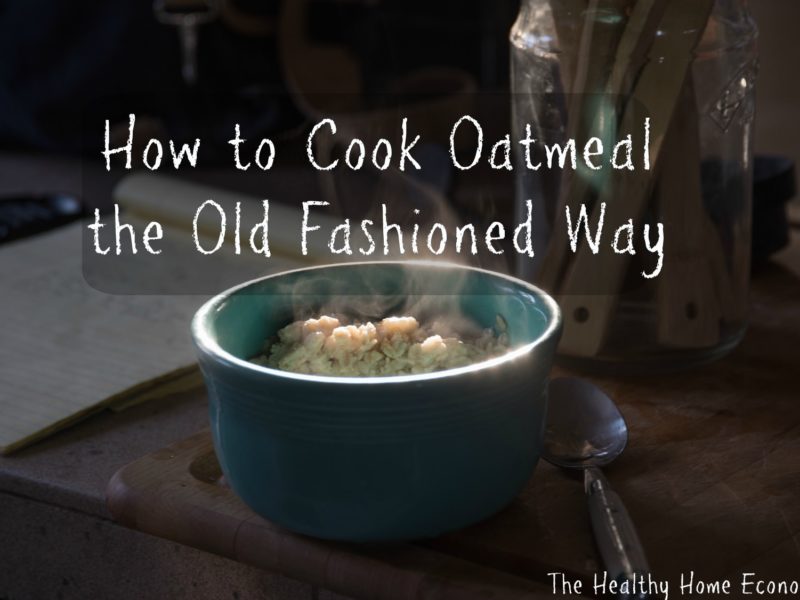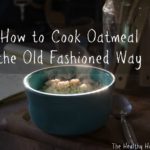How to soak and cook oatmeal the traditional way, aka “overnight oats” for a digestible and nourishing breakfast that will keep you feeling full all the way to lunch!

How do you cook oatmeal the healthiest way possible? Is it acceptable to cook it in the microwave, quickly poured out of convenient, ready to use packets? Do you think this is a healthy start to the day?
Reality Check: Ripping open a package of instant oatmeal, pouring it in a mug with some water and nuking it in the microwave for a couple of minutes is NOT a nourishing breakfast! And guess what … you will feel hungry again about an hour later!
Don’t get me wrong here – oatmeal can and should be a healthy breakfast!
How you choose to cook oatmeal, however, is the critical step that most people completely miss and which determines how much nourishment and benefit you will actually derive from the experience. It is one of the most important cooking skills to learn yourself and teach children before they leave home.
Preparation determines how long the oatmeal will fill you up. What good is a bowl of oatmeal if you are hungry again and ready for a donut fix by 10 am?
Overnight Oats the Traditional Way
Learning to prepare overnight oats as practiced for centuries by ancestral societies will take a little planning on your part. But, you will be greatly rewarded with a much more nourishing, digestible breakfast that will stay with you all the way to lunchtime!
Traditional peoples knew through observation that grains were very hard to digest and caused health problems over time for those who consumed them without careful preparation.
Throwing out those boxed breakfast cereals that are at least twice as expensive per serving and toxic to boot and replacing with a simple, nutritious bowl of porridge will also help your food budget considerably with no loss in pleasure or enjoyment particularly on chilly winter mornings!
TIP: I’ve had people email me to complain that when you cook oatmeal by first soaking for at least 7 hours or overnight, it results in a sour tasting porridge. I’ve found that soaking in water plus lemon juice produces a delightful and slightly lemony porridge that is not sour at all and absolutely pops with flavor! If you still need help adjusting to the taste of soaked oatmeal, the linked article plus video will share an easy way to slowly adapt.

How to Cook Oatmeal (traditional method)
The traditional method for preparing overnight oats and cooking oatmeal the next morning that results in a bowl of porridge that is very digestible, filling and nourishing compared to modern convenience methods.
Ingredients
- 1 cup rolled oats preferably organic
- 2-3 cups filtered water
- 1-2 Tbl lemon juice optional
- 1/2 tsp sea salt
Instructions
-
Mix the oats, 2 cups of water, and lemon juice in a pot. Cover and leave on the counter (NOT in the refrigerator) for at least 7 hours or overnight. If you have trouble digesting grains, feel free to soak for as long as 24 hours.
-
When soaking is complete, add 1/2-1 cup additional filtered water to the pot. Bring to a boil with the salt. Cook oatmeal thoroughly for 5 minutes. You do not need to rinse the oats before cooking.
-
Traditional oatmeal is best served with butter and/or cream for optimal assimilation of minerals. A natural sweetener, nuts, raisins or other fruit may be added as desired.
-
Refrigerate leftovers.
Recipe Video
Recipe Notes
Store bought or homemade apple cider vinegar, yogurt, or kefir may be substituted for the lemon juice.
If you are just starting to soak oatmeal for breakfast, feel free to just soak with water at first and gradually build up to the 4 tablespoons of recommended acidic medium (I prefer lemon juice).
Detailed Video Tutorial
In this longer video below, I show you exactly how I cook rolled oats into oatmeal.
It requires the initial step of soaking the night before. Then, it cooks up quickly the next morning!
Be sure to refrigerate any leftovers for a fast warm-up on the stove on subsequent mornings.
No Rinsing Required
You do not need to rinse the soaked oats before cooking. The antinutrients are deactivated, so no further effort is needed other than simmering for a few minutes on the stove!
I do not recommend soaking oat groats. The linked article explains why.
Soaked Oats vs Sprouted
If you don’t think you can manage the two minutes it takes before you go to bed to put on a pot of oatmeal to soak, this article shows you how to prepare traditional oatmeal without soaking using sprouted rolled oats instead.
This article on sprouting vs soaking explains the differences nutritionally and digestively speaking.
More Soaked Porridges to Enjoy!
If you find overnight oats to be enjoyable and more digestible, try amaranth breakfast cereal, teff porridge and buckwheat hot cereal too.








I have heard that it’s best to dump soaking water, as it contains all the phytic acid? Thoughts?
No, the phytic acid is deactivated. No need to dump the soaking water.
We love soaked oats! I didn’t know it was good for milk supply. Being five months pregnant that will come in handy!!
If Phytic acid keeps minerals locked in nuts and seeds until they are in the process of sprouting, then if I buy sprouted oatmeal do I still need to soak it?
This is so helpful! Just to be sure, are you saying that the next morning you don’t dump out the soaking water and rinse it? Wow I’ve been doing that all along!
Hi Sara,
I suffer from leaky gut and candida. I have been told to rule out all grains. Is it safe for me to eat them if they are soaked over night?
Probably not for the time being.. check into the GAPS Diet which will temporarily remove grains from your diet until your gut is healed and sealed.
OK, thank you Sara. I am working on getting it healed now.
What about soaked oat groats? Can I use this same recipe? more water?
What about using a slow cooker? I want my oatmeal to be ready when I wake up. Does the soaking with the acidic medium still achieve the same goal when it is in a slow cooker all night instead of just sitting on the counter? In other words, would the low heat prohibit the neutralizing process? I would think not, but just wanted to make sure. Thanks, I would appreciate a response.
I accidentally added the salt to the oatmeal before soaking. Will this ruin it? I soaked it overnight. Can I still use it?
HERE IS THE ANSWER:
In a comparison of the ability of grains to break down phytic acid by soaking, even with an acid in the soak water, oats and corn were stand-outs: you can soak all you want and still end up with the same amount of phytic acid. You are wasting your time and your ingredients by trying to soak your oats with lemon juice, apple cider vinegar, or yogurt.
The phytic acid in wheat and rye was reduces entirely in one hour or soaking, and barley in 2 hours. Oats and corn when soaked for 12 hours still retain 75% of their original phytic acid content. Research has shown that millet and brown rice can be difficult too in removing phytic acid.
The key to making the most of your oatmeal is “complementary soaking” which is to add a high-phytase grain to a low phytase grain. The reason that the phytic acid declined so much in the wheat, rye, and barley in experiments is that they have higher levels of the enzyme phytase that work to break down the phytic acid.
Phytase level in rye is extremely high. Wheat and buckwheat are very high also. Corn, rice, soybeans and chickpea all have low levels. Oats have very low levels as well based on the difficulty researchers had in reducing the phytic acid.
So the solution for soaking oats is to keep whole rye kernels on hand (or hulled raw buckwheat in a gluten-free kitchen (Not kasha or roasted buckwheat but raw hulled buckwheat – some Wholefoods and Health Food stores carry it) and a coffee grinder. Grind 1 or 2 tablespoon of rye kernels or buckwheat in the coffee grinder and add the ground rye or buckwheat to your soak water for the oats.
That makes sense with the phytase enzyme, same as to why some say raw milk is easily digested due to lactase to help with digestion of lactose. I have heard now several times that it is best to mix different grains before consuming. I would be interested to hear Sarah’s thoughts on this.
Hi Stacey, I would be grateful to know your resources for what you wrote. I am a member of a WPF chapter in NY and will be doing a presentation on grains soon. I have heard variations on what you are saying, but have been having trouble finding resources to share that others can access beyond posts and comments here and there.
This makes a lot of sense. I read this somewhere else too, that phytase is key in breaking down Phytic Acid.
Ok, so. I’m actually concerned because my oatmeal didn’t taste or smell like vinegar at all! This obviously is alright by me! (I soaked it 8 hours), but I used white vinegar, as I’m out of apple cider vinegar. Is white ok to use?